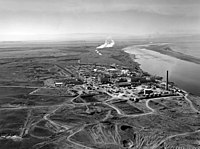
Photo from wikipedia
Abstract Lead-Boron Polyethylene (PbBPE) composite formed by diffusing lead and boron carbide powders in the polyethylene is a typical shielding material for radiation protection in nuclear facilities. Cement solidification of… Click to show full abstract
Abstract Lead-Boron Polyethylene (PbBPE) composite formed by diffusing lead and boron carbide powders in the polyethylene is a typical shielding material for radiation protection in nuclear facilities. Cement solidification of contaminated PbBPE could result in the waste volume increase and the radionuclides leaching risk. This study aimed to apply the thermal treatment to reduce the volume of PbBPE and immobilize radionuclides into the stable waste form by turning PbBPE into glass. PE could be pyrolyzed at ~450 oC, while the residual lead and boron were converted into an undurable lead borate glass at temperature above 900 oC. The volume of the waste decreased more than twice after thermal treatment, and the durability of the lead borate glass was enhanced by addition of SiO2. The 7-day Product Consistency Test normalized releases for elements (Pb, B, Co, Sr and Cs) were
Journal Title: Journal of Non-Crystalline Solids
Year Published: 2021
Link to full text (if available)
Share on Social Media: Sign Up to like & get
recommendations!